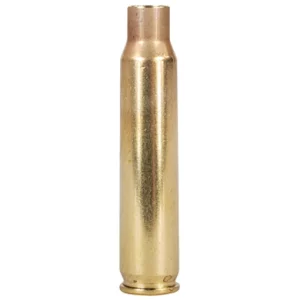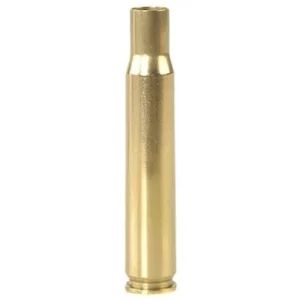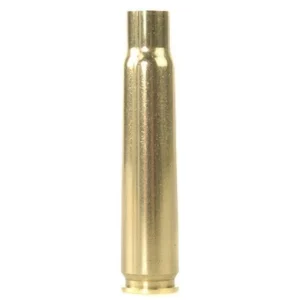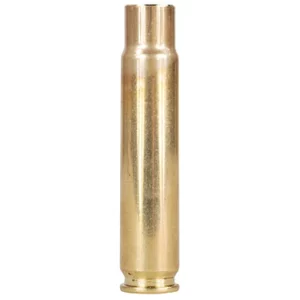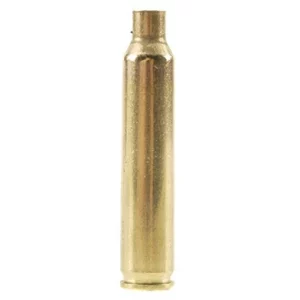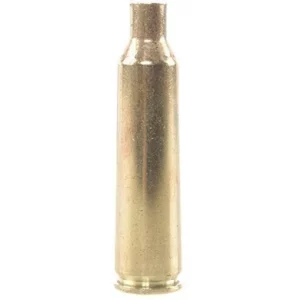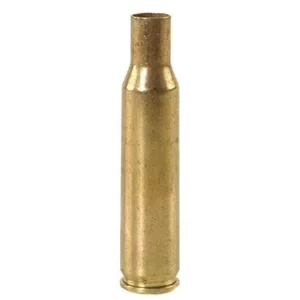Reloading Brass
-
Quality Cartridge Brass 6.5mm-257 Roberts Box of 20
Quality Cartridge started in 1990 manufacturing custom, obsolete and wildcat cartridge cases. Quality Cartridge uses the highest quality materials and equipment to produce the best brass available. Along with the high quality of their products Quality Cartridge also properly head stamps over 450 different calibers from popular wildcats to obsolete cartridges. It is easy to see why Quality Cartridge has become the go-to source for obscure cartridge needs.
Because of variations in case size for some specialty cartridges, it is best to check the brass against a fired case from a particular firearm to ensure suitability. Whenever possible, brass has been formed to published standards for the cartridge. This is not loaded ammunition.
Brass Preparation: With bulk rifle brass you may sometimes notice a few case mouths are “out of round” or slightly dented below the shoulder. These imperfections occur in the final tumbling wash operation after the case mouth has been annealed. Brass manufacturers are aware of the case cosmetics and have worked to mitigate it, but due to equipment design, denting may still occur. Minor dents are normally removed in the first firing and will not affect case life or performance. On non-plated brass, you may also notice all the anneal stain might not be polished off, which may give the case neck a pinkish color. With some smaller caliber cases you may notice the case mouths to be slightly belled.
With all new rifle brass, you should first straighten out the case and case mouth, then chamfer and debur the case mouth inside and out. To straighten the case mouth, run the case part way into the sizer die and let the expander ball straighten the brass. To prevent the case neck from stretching, be sure to lubricate the case neck inside the case mouth.
CAD $51.00 -
Quality Cartridge Brass 6mm-06 Springfield Box of 20
Quality Cartridge started in 1990 manufacturing custom, obsolete and wildcat cartridge cases. Quality Cartridge uses the highest quality materials and equipment to produce the best brass available. Along with the high quality of their products Quality Cartridge also properly head stamps over 450 different calibers from popular wildcats to obsolete cartridges. It is easy to see why Quality Cartridge has become the go-to source for obscure cartridge needs.
Because of variations in case size for some specialty cartridges, it is best to check the brass against a fired case from a particular firearm to ensure suitability. Whenever possible, brass has been formed to published standards for the cartridge. This is not loaded ammunition.
Brass Preparation: With bulk rifle brass you may sometimes notice a few case mouths are “out of round” or slightly dented below the shoulder. These imperfections occur in the final tumbling wash operation after the case mouth has been annealed. Brass manufacturers are aware of the case cosmetics and have worked to mitigate it, but due to equipment design, denting may still occur. Minor dents are normally removed in the first firing and will not affect case life or performance. On non-plated brass, you may also notice all the anneal stain might not be polished off, which may give the case neck a pinkish color. With some smaller caliber cases you may notice the case mouths to be slightly belled.
With all new rifle brass, you should first straighten out the case and case mouth, then chamfer and debur the case mouth inside and out. To straighten the case mouth, run the case part way into the sizer die and let the expander ball straighten the brass. To prevent the case neck from stretching, be sure to lubricate the case neck inside the case mouth.
CAD $51.00 -
Quality Cartridge Brass 6x45mm (6mm-223 Remington) Box of 20
Quality Cartridge started in 1990 manufacturing custom, obsolete and wildcat cartridge cases. Quality Cartridge uses the highest quality materials and equipment to produce the best brass available. Along with the high quality of their products Quality Cartridge also properly head stamps over 450 different calibers from popular wildcats to obsolete cartridges. It is easy to see why Quality Cartridge has become the go-to source for obscure cartridge needs.
Because of variations in case size for some specialty cartridges, it is best to check the brass against a fired case from a particular firearm to ensure suitability. Whenever possible, brass has been formed to published standards for the cartridge. This is not loaded ammunition.
Brass Preparation: With bulk rifle brass you may sometimes notice a few case mouths are “out of round” or slightly dented below the shoulder. These imperfections occur in the final tumbling wash operation after the case mouth has been annealed. Brass manufacturers are aware of the case cosmetics and have worked to mitigate it, but due to equipment design, denting may still occur. Minor dents are normally removed in the first firing and will not affect case life or performance. On non-plated brass, you may also notice all the anneal stain might not be polished off, which may give the case neck a pinkish color. With some smaller caliber cases you may notice the case mouths to be slightly belled.
With all new rifle brass, you should first straighten out the case and case mouth, then chamfer and debur the case mouth inside and out. To straighten the case mouth, run the case part way into the sizer die and let the expander ball straighten the brass. To prevent the case neck from stretching, be sure to lubricate the case neck inside the case mouth.
CAD $45.00 -
Quality Cartridge Brass 8mm-06 Springfield Box of 20
Quality Cartridge started in 1990 manufacturing custom, obsolete and wildcat cartridge cases. Quality Cartridge uses the highest quality materials and equipment to produce the best brass available. Along with the high quality of their products Quality Cartridge also properly head stamps over 450 different calibers from popular wildcats to obsolete cartridges. It is easy to see why Quality Cartridge has become the go-to source for obscure cartridge needs.
Because of variations in case size for some specialty cartridges, it is best to check the brass against a fired case from a particular firearm to ensure suitability. Whenever possible, brass has been formed to published standards for the cartridge. This is not loaded ammunition.
Brass Preparation: With bulk rifle brass you may sometimes notice a few case mouths are “out of round” or slightly dented below the shoulder. These imperfections occur in the final tumbling wash operation after the case mouth has been annealed. Brass manufacturers are aware of the case cosmetics and have worked to mitigate it, but due to equipment design, denting may still occur. Minor dents are normally removed in the first firing and will not affect case life or performance. On non-plated brass, you may also notice all the anneal stain might not be polished off, which may give the case neck a pinkish color. With some smaller caliber cases you may notice the case mouths to be slightly belled.
With all new rifle brass, you should first straighten out the case and case mouth, then chamfer and debur the case mouth inside and out. To straighten the case mouth, run the case part way into the sizer die and let the expander ball straighten the brass. To prevent the case neck from stretching, be sure to lubricate the case neck inside the case mouth.
CAD $46.00 -
Quality Cartridge Brass 8x56mm Mannlicher-Schoenauer Box of 20
Quality Cartridge started in 1990 manufacturing custom, obsolete and wildcat cartridge cases. Quality Cartridge uses the highest quality materials and equipment to produce the best brass available. Along with the high quality of their products Quality Cartridge also properly head stamps over 450 different calibers from popular wildcats to obsolete cartridges. It is easy to see why Quality Cartridge has become the go-to source for obscure cartridge needs.
Because of variations in case size for some specialty cartridges, it is best to check the brass against a fired case from a particular firearm to ensure suitability. Whenever possible, brass has been formed to published standards for the cartridge. This is not loaded ammunition.
Brass Preparation: With bulk rifle brass you may sometimes notice a few case mouths are “out of round” or slightly dented below the shoulder. These imperfections occur in the final tumbling wash operation after the case mouth has been annealed. Brass manufacturers are aware of the case cosmetics and have worked to mitigate it, but due to equipment design, denting may still occur. Minor dents are normally removed in the first firing and will not affect case life or performance. On non-plated brass, you may also notice all the anneal stain might not be polished off, which may give the case neck a pinkish color. With some smaller caliber cases you may notice the case mouths to be slightly belled.
With all new rifle brass, you should first straighten out the case and case mouth, then chamfer and debur the case mouth inside and out. To straighten the case mouth, run the case part way into the sizer die and let the expander ball straighten the brass. To prevent the case neck from stretching, be sure to lubricate the case neck inside the case mouth.
CAD $61.00 -
Quality Cartridge Brass 9.5x56mm Mannlicher-Schoenauer Box of 20
Quality Cartridge started in 1990 manufacturing custom, obsolete and wildcat cartridge cases. Quality Cartridge uses the highest quality materials and equipment to produce the best brass available. Along with the high quality of their products Quality Cartridge also properly head stamps over 450 different calibers from popular wildcats to obsolete cartridges. It is easy to see why Quality Cartridge has become the go-to source for obscure cartridge needs.
Because of variations in case size for some specialty cartridges, it is best to check the brass against a fired case from a particular firearm to ensure suitability. Whenever possible, brass has been formed to published standards for the cartridge. This is not loaded ammunition.
Brass Preparation: With bulk rifle brass you may sometimes notice a few case mouths are “out of round” or slightly dented below the shoulder. These imperfections occur in the final tumbling wash operation after the case mouth has been annealed. Brass manufacturers are aware of the case cosmetics and have worked to mitigate it, but due to equipment design, denting may still occur. Minor dents are normally removed in the first firing and will not affect case life or performance. On non-plated brass, you may also notice all the anneal stain might not be polished off, which may give the case neck a pinkish color. With some smaller caliber cases you may notice the case mouths to be slightly belled.
With all new rifle brass, you should first straighten out the case and case mouth, then chamfer and debur the case mouth inside and out. To straighten the case mouth, run the case part way into the sizer die and let the expander ball straighten the brass. To prevent the case neck from stretching, be sure to lubricate the case neck inside the case mouth.
CAD $82.00 -
Remington Brass 204 Ruger Bag of 100
Remington cartridge cases are carefully drawn from specially-alloyed brass to provide consistently exact internal volume and resistance to case stretching and brittleness. Primer pocket tolerances are held to .001″, and closely monitored case neck annealing ensures easier re-sizing and longer reloading life. New, unprimed brass. This is not loaded ammunition. Bulk brass should be full-length sized, trimmed and chamfered before loading.
Brass Preparation: With bulk rifle brass you may sometimes notice a few case mouths are “out of round” or slightly dented below the shoulder. These imperfections occur in the final tumbling wash operation after the case mouth has been annealed. Brass manufacturers are aware of the case cosmetics and have worked to mitigate it, but due to equipment design, denting may still occur. Minor dents are normally removed in the first firing and will not affect case life or performance. On non-plated brass, you may also notice all the anneal stain might not be polished off, which may give the case neck a pinkish color. With some smaller caliber cases you may notice the case mouths to be slightly belled.With all new rifle brass, you should first straighten out the case and case mouth, then chamfer and debur the case mouth inside and out. To straighten the case mouth, run the case part way into the sizer die and let the expander ball straighten the brass. To prevent the case neck from stretching, be sure to lubricate the case neck inside the case mouth.
If you are using Nickel plated brass, special care must be taken to lubricate the cases prior to sizing them. Nickel plating is harder than brass and the cases require more effort in sizing. In the event a case becomes stuck, purchase a stuck case remover; don’t use pliers, screwdrivers or other common household tools which could damage your sizing die.
CAD $58.05Remington Brass 204 Ruger Bag of 100
CAD $58.05 -
Remington Brass 22 Hornet Bag of 100
Remington cartridge cases are carefully drawn from specially-alloyed brass to provide consistently exact internal volume and resistance to case stretching and brittleness. Primer pocket tolerances are held to .001″, and closely monitored case neck annealing ensures easier re-sizing and longer reloading life. New, unprimed brass. This is not loaded ammunition. Bulk brass should be full-length sized, trimmed and chamfered before loading.
Brass Preparation: With bulk rifle brass you may sometimes notice a few case mouths are “out of round” or slightly dented below the shoulder. These imperfections occur in the final tumbling wash operation after the case mouth has been annealed. Brass manufacturers are aware of the case cosmetics and have worked to mitigate it, but due to equipment design, denting may still occur. Minor dents are normally removed in the first firing and will not affect case life or performance. On non-plated brass, you may also notice all the anneal stain might not be polished off, which may give the case neck a pinkish color. With some smaller caliber cases you may notice the case mouths to be slightly belled.With all new rifle brass, you should first straighten out the case and case mouth, then chamfer and debur the case mouth inside and out. To straighten the case mouth, run the case part way into the sizer die and let the expander ball straighten the brass. To prevent the case neck from stretching, be sure to lubricate the case neck inside the case mouth.
If you are using Nickel plated brass, special care must be taken to lubricate the cases prior to sizing them. Nickel plating is harder than brass and the cases require more effort in sizing. In the event a case becomes stuck, purchase a stuck case remover; don’t use pliers, screwdrivers or other common household tools which could damage your sizing die.
CAD $54.00Remington Brass 22 Hornet Bag of 100
CAD $54.00 -
Remington Brass 22-250 Remington Bag of 100
Remington cartridge cases are carefully drawn from specially-alloyed brass to provide consistently exact internal volume and resistance to case stretching and brittleness. Primer pocket tolerances are held to .001″, and closely monitored case neck annealing ensures easier re-sizing and longer reloading life. New, unprimed brass. This is not loaded ammunition. Bulk brass should be full-length sized, trimmed and chamfered before loading.
Brass Preparation: With bulk rifle brass you may sometimes notice a few case mouths are “out of round” or slightly dented below the shoulder. These imperfections occur in the final tumbling wash operation after the case mouth has been annealed. Brass manufacturers are aware of the case cosmetics and have worked to mitigate it, but due to equipment design, denting may still occur. Minor dents are normally removed in the first firing and will not affect case life or performance. On non-plated brass, you may also notice all the anneal stain might not be polished off, which may give the case neck a pinkish color. With some smaller caliber cases you may notice the case mouths to be slightly belled.With all new rifle brass, you should first straighten out the case and case mouth, then chamfer and debur the case mouth inside and out. To straighten the case mouth, run the case part way into the sizer die and let the expander ball straighten the brass. To prevent the case neck from stretching, be sure to lubricate the case neck inside the case mouth.
If you are using Nickel plated brass, special care must be taken to lubricate the cases prior to sizing them. Nickel plating is harder than brass and the cases require more effort in sizing. In the event a case becomes stuck, purchase a stuck case remover; don’t use pliers, screwdrivers or other common household tools which could damage your sizing die.
CAD $91.80Remington Brass 22-250 Remington Bag of 100
CAD $91.80 -
Remington Brass 222 Remington Bag of 100
Remington cartridge cases are carefully drawn from specially-alloyed brass to provide consistently exact internal volume and resistance to case stretching and brittleness. Primer pocket tolerances are held to .001″, and closely monitored case neck annealing ensures easier re-sizing and longer reloading life. New, unprimed brass. This is not loaded ammunition. Bulk brass should be full-length sized, trimmed and chamfered before loading.
Brass Preparation: With bulk rifle brass you may sometimes notice a few case mouths are “out of round” or slightly dented below the shoulder. These imperfections occur in the final tumbling wash operation after the case mouth has been annealed. Brass manufacturers are aware of the case cosmetics and have worked to mitigate it, but due to equipment design, denting may still occur. Minor dents are normally removed in the first firing and will not affect case life or performance. On non-plated brass, you may also notice all the anneal stain might not be polished off, which may give the case neck a pinkish color. With some smaller caliber cases you may notice the case mouths to be slightly belled.With all new rifle brass, you should first straighten out the case and case mouth, then chamfer and debur the case mouth inside and out. To straighten the case mouth, run the case part way into the sizer die and let the expander ball straighten the brass. To prevent the case neck from stretching, be sure to lubricate the case neck inside the case mouth.
If you are using Nickel plated brass, special care must be taken to lubricate the cases prior to sizing them. Nickel plating is harder than brass and the cases require more effort in sizing. In the event a case becomes stuck, purchase a stuck case remover; don’t use pliers, screwdrivers or other common household tools which could damage your sizing die.
CAD $66.15Remington Brass 222 Remington Bag of 100
CAD $66.15 -
Remington Brass 223 Remington Bag of 100
Remington cartridge cases are carefully drawn from specially-alloyed brass to provide consistently exact internal volume and resistance to case stretching and brittleness. Primer pocket tolerances are held to .001″, and closely monitored case neck annealing ensures easier re-sizing and longer reloading life. New, unprimed brass. This is not loaded ammunition. Bulk brass should be full-length sized, trimmed and chamfered before loading.
Brass Preparation: With bulk rifle brass you may sometimes notice a few case mouths are “out of round” or slightly dented below the shoulder. These imperfections occur in the final tumbling wash operation after the case mouth has been annealed. Brass manufacturers are aware of the case cosmetics and have worked to mitigate it, but due to equipment design, denting may still occur. Minor dents are normally removed in the first firing and will not affect case life or performance. On non-plated brass, you may also notice all the anneal stain might not be polished off, which may give the case neck a pinkish color. With some smaller caliber cases you may notice the case mouths to be slightly belled.With all new rifle brass, you should first straighten out the case and case mouth, then chamfer and debur the case mouth inside and out. To straighten the case mouth, run the case part way into the sizer die and let the expander ball straighten the brass. To prevent the case neck from stretching, be sure to lubricate the case neck inside the case mouth.
If you are using Nickel plated brass, special care must be taken to lubricate the cases prior to sizing them. Nickel plating is harder than brass and the cases require more effort in sizing. In the event a case becomes stuck, purchase a stuck case remover; don’t use pliers, screwdrivers or other common household tools which could damage your sizing die.
CAD $58.05Remington Brass 223 Remington Bag of 100
CAD $58.05 -
Remington Brass 243 Winchester Bag of 50
Remington cartridge cases are carefully drawn from specially-alloyed brass to provide consistently exact internal volume and resistance to case stretching and brittleness. Primer pocket tolerances are held to .001″, and closely monitored case neck annealing ensures easier re-sizing and longer reloading life. New, unprimed brass. This is not loaded ammunition. Bulk brass should be full-length sized, trimmed and chamfered before loading.
Brass Preparation: With bulk rifle brass you may sometimes notice a few case mouths are “out of round” or slightly dented below the shoulder. These imperfections occur in the final tumbling wash operation after the case mouth has been annealed. Brass manufacturers are aware of the case cosmetics and have worked to mitigate it, but due to equipment design, denting may still occur. Minor dents are normally removed in the first firing and will not affect case life or performance. On non-plated brass, you may also notice all the anneal stain might not be polished off, which may give the case neck a pinkish color. With some smaller caliber cases you may notice the case mouths to be slightly belled.With all new rifle brass, you should first straighten out the case and case mouth, then chamfer and debur the case mouth inside and out. To straighten the case mouth, run the case part way into the sizer die and let the expander ball straighten the brass. To prevent the case neck from stretching, be sure to lubricate the case neck inside the case mouth.
If you are using Nickel plated brass, special care must be taken to lubricate the cases prior to sizing them. Nickel plating is harder than brass and the cases require more effort in sizing. In the event a case becomes stuck, purchase a stuck case remover; don’t use pliers, screwdrivers or other common household tools which could damage your sizing die.
CAD $51.30Remington Brass 243 Winchester Bag of 50
CAD $51.30



